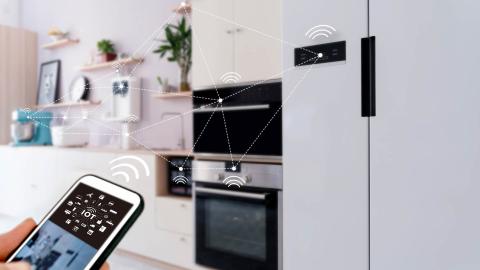
Smart home devices have the potential to reduce energy consumption, manage demand, support time-of-use rate structures, and share valuable energy data with customers, among other benefits. And while we’ve seen widespread success with smart thermostats in utility programs, other smart home options have seen limited adoption. To better establish the energy and non-energy benefits of various products and systems, and to identify utility program best practices, my colleague Clare Valentine and I wrote a paper that was recently published in the proceedings of the 2020 ACEEE Summer Study on Energy Efficiency in Buildings titled Making the Smart Home Work for You: Wrangling Energy and Demand Benefits Out of Connected Tech (PDF).
What our smart home research revealed
From an energy-saving perspective, the most promising devices currently include smart thermostats, window coverings, and plugs.
We focused on seven promising end uses for energy management: thermostats, lighting, plugs, appliances, water heating, electric vehicle (EV) charging, and window coverings. Here are some of our top findings:
- According to ethnographic research performed for the E Source E Design 2020 initiative, saving time, having peace of mind, and saving money are the primary considerations that drive smart home device ownership. Secondary drivers include the “cool” factor associated with owning high-tech smart home devices, and energy savings.
- From an energy-saving perspective, the most promising devices are smart thermostats, window coverings, and plugs.
- Smart EV charging, thermostats, and water heating appear to offer the greatest opportunities for reducing demand and shifting load.
- Some smart devices—such as smart lighting and smart appliances—currently offer relatively little in the way of energy or demand benefits, but their non-energy benefits appeal to customers. And they may help utilities make smart home kits or other comprehensive offerings more appealing.
- There’s a clear need for further research into the potential benefits of smart devices and systems. Unfortunately, because many smart devices rely on some combination of site-specific automation and behavior change to drive energy and demand savings, current measurement and verification (M&V) frameworks are ill-suited for evaluating these technologies. And utility savings assumptions rarely account for software-based measures with energy benefits that can change dramatically through over-the-air updates on short notice.
- As utilities, program implementers, and manufacturers continue to collaborate, bring-your-own-device (BYOD) and marketplace-based offerings increasingly show potential.
Open platforms offer opportunities for utilities and their partners
Beyond individual devices, a growing number of vendors are creating energy-focused smart home systems and services—from home energy management platforms that provide energy data and analysis with limited smart device control to smart home-as-a-service offerings that focus on energy as just one component of a broader system. There are also a handful of open platforms that are free or low-cost, are largely vendor agnostic, and may offer a range of opportunities for utilities and their partners. Here are a few of our takeaways for several prominent open platforms:
- Emerging smart home systems meeting the new ENERGY STAR Smart Home Energy Management Systems (SHEMS) specification are likely to work well for utility programs because of their potential to yield energy, demand, rate, and educational benefits, but potential energy and demand reductions are currently unclear.
- IFTTT is a free service designed to help users connect a wide range of apps and devices and facilitate do-it-yourself automation. It offers a flexible platform that may be especially effective in engaging and supporting more tech-savvy customers, though it may complicate M&V efforts and could run into ongoing interoperability challenges with individual smart devices.
- Voice assistants like Amazon’s Alexa and the Google Assistant are seeing tremendous market adoption and could offer numerous benefits for utilities as a new communication and engagement channel, but they need more work before automated smart device coordination for energy management purposes is a viable opportunity.
Overall, given the rapid market evolution in the smart home space and the many potential benefits for utilities, we expect smart devices and smart home systems will become increasingly important components of residential utility efficiency, load management, customer engagement, and decarbonization initiatives. But several technical and programmatic challenges remain, and utilities and their partners need to adopt new approaches to better understand real-world performance, assess actual energy benefits, and fit each technology or system to the needs of their customers.
To learn more, check out our paper Making the Smart Home Work for You: Wrangling Energy and Demand Benefits Out of Connected Tech (PDF). And E Source utility members can visit our Smart home resource center for a comprehensive list of E Source smart home research and reports.